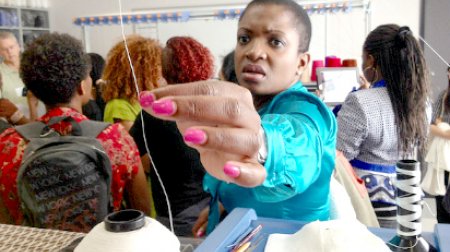1940 – Nelson Rockefeller was named the Coordinator of Commercial and Cultural Affairs for the American Republics. He initiated the exchange of persons program with Latin America, inviting 130 Latin American journalists to the United States.
February, 1942 – A network of fourteen private shortwave transmitters began broadcasting the newly created Voice of America.
June, 1942 – The Office of War Information (OWI) was established to consolidate scattered agencies of domestic and foreign information.
1946 – OWI was terminated by President Truman, and a small remnant was placed within the State Department. The wartime total of 11,000 personnel shrank to 3,000 including the Voice of America. Within the State Department, the Office of International Information and Cultural Affairs (OIC) in 1946 had a network of 76 branches the world over. Wireless files carried daily news and feature stories from Washington. Sixty-seven information centers and libraries stocked books, displayed exhibits and showed films. The Voice of America broadcasted to the world for a total of 36 hours in 24 languages.
1947 – OIC was renamed the Office of International Information and Educational Exchange.
1948 – Representative Karl E. Mundt and Senator H. Alexander Smith marshaled a bill through Congress. Public Law 402, 80th Congress, commonly called the Smith-Mundt Act, established a statutory information agency for the first time in a period of peace with a mission to "promote a better understanding of the United States in other countries, and to increase mutual understanding" between Americans and foreigners. The Smith-Mundt Act gave full recognition to the importance of educational and cultural exchanges sponsored by the government. In recognition of the need to build up a corps of well-informed intellectuals and opinion leaders in the political and social infrastructure, the International Visitor Program was started.
1952 – The program was consolidated into the exchange of persons program of the State Department.
1953 – President Eisenhower submitted Reorganization Plan Number 8 to Congress which established the United States Information Agency (USIA) to consolidate information functions administered by the State Department and other agencies. The Voice of America was joined to USIA but the educational and cultural exchanges remained with the State Department.
1959 – The exchange function was separated from the Bureau of Public Affairs and was assigned to a newly created Bureau of Educational and Cultural Relations.
1960- The Bureau of Educational and Cultural Relations is renamed the Bureau of Educational and Cultural Affairs
1961 – Fulbright-Hays Act is passed and reaffirms the objective of increasing mutual understanding between the people of the United States and the people of other nations.
1978 – USIA is renamed the United States International Communication Agency (USICA) with responsibility for the public diplomacy of the U.S. It combined the information mission with the educational and cultural exchanges through absorbing the Bureau of Educational and Cultural Relations from the State Department.
1982 – The Reagan Administration changed the name back to the United States Information Agency.
1999 – USIA is moved into the U.S. Department of State. The Bureau of Educational and Cultural Affairs maintains its authority under the Fulbright-Hays Act. The International Visitor Program continues under the Bureau.
2004 - The International Visitor Program's name changed to The International Visitor Leadership Program. Over 4500 visitors participated in the International Visitor Leadership Program from October 2003 – September 2004.
In their own words


